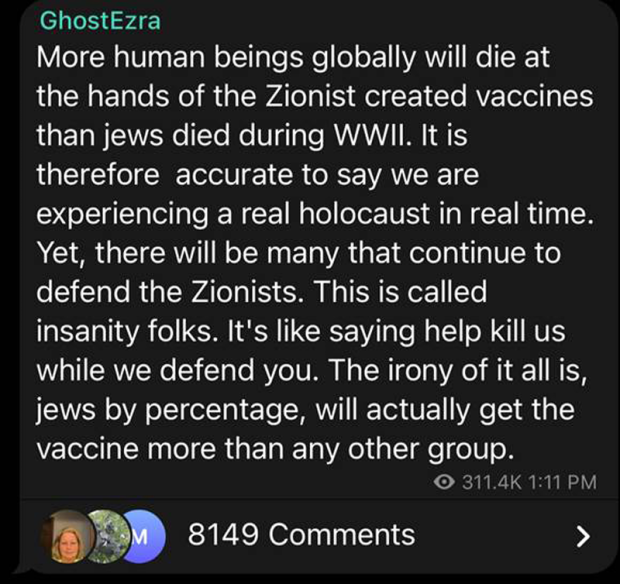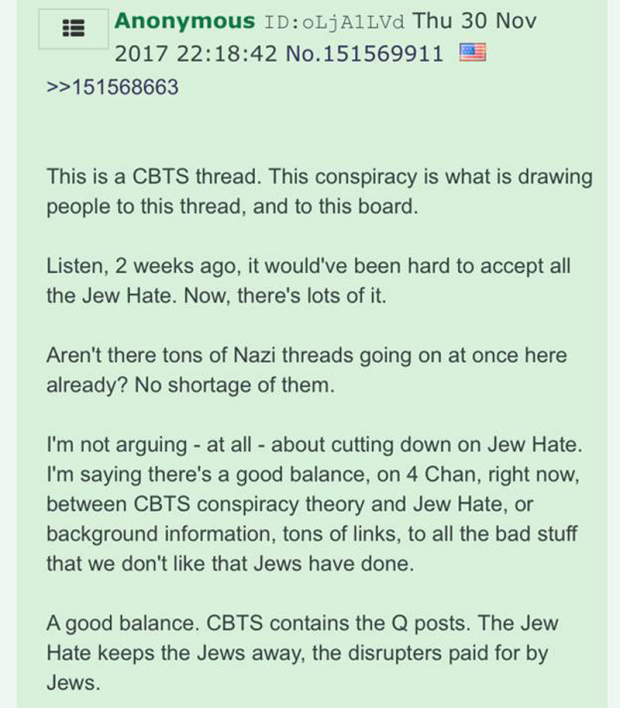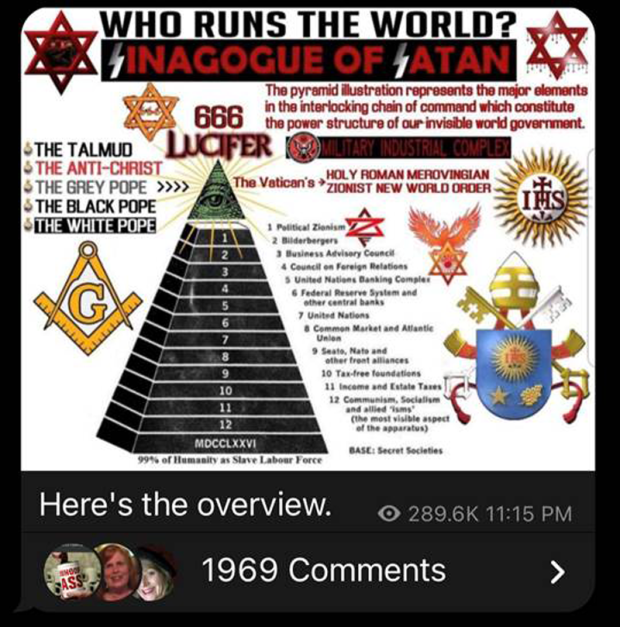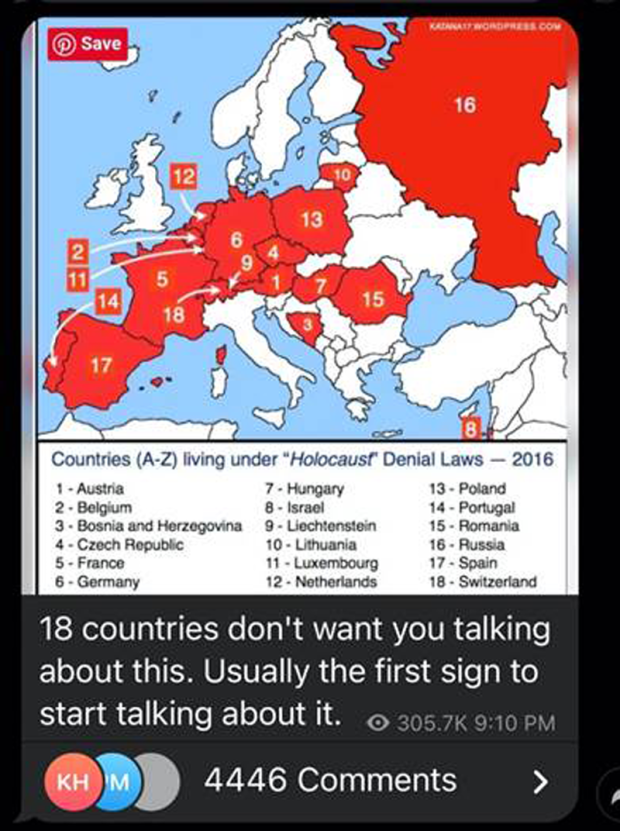
Introduction
If there is a single thread that links QAnon’s origins, its current state, and where the conspiracy theory is likely to go in the short- to medium-term, it’s antisemitism. QAnon’s antisemitism has been most visible at two points: its beginnings – when it emerged from the swastika-studded fever swamp that is 4chan – and the present, when the most popular QAnon influencer, GhostEzra, is an open Nazi who praises Hitler, admires the Third Reich, and decries the supposedly treacherous nature of Jews.
This is not to say that antisemitism was absent, or even dormant, between QAnon’s beginning and the current moment. During that period, some of QAnon’s foremost proponents – including its single most successful recruiter – indulged in overt antisemitism.
However, when QAnon exploded off 4chan and 8chan into the wider internet, the movement attracted a crowd that was less habitually antisemitic than the early adopters had been. Only in recent months, after President Joe Biden’s inauguration, has this comparatively mainstream crowd begun to drift away. Those who remain are, by definition, more deeply committed than the ones who’ve left.
Before we delve into the movement’s history, though, it would probably be wise to explain what QAnon is.
QAnon is a sprawling conspiracy theory that alleges (among other things) that Hollywood and the upper echelons of the Democratic Party are controlled by a cabal of Satanic pedophiles. The eponymous Q of QAnon, according to the theory’s lore, is part of a team of military intelligence operatives and high-level civilian insiders (the “Q Team”) that will eventually dismantle the cabal, in collaboration with former president Donald J. Trump. Ostensibly to prevent mass panic during the apprehension of the cabal, Q chose to leak the general outlines of this plan to the online communities of 4chan and, later, 8chan.
By sharing the plan, Q claimed, part of the population would be forewarned and could explain the benevolent nature of Q’s actions to their neighbors, who might otherwise find it suspicious that all of Trump’s enemies were being arrested, then given show trials and executed.
QAnon began on 4chan but spread rapidly to the more-mainstream internet, first by way of Reddit communities such as r/conspiracy and then via other social media.
Between October of 2017 and December of 2020, Q made almost 5,000 posts (known as “Q drops”). Within six months of Q’s first posts, some of Q’s followers had created sites called “aggregators.” The aggregators collected Q’s content and presented it in a medium far removed from the open-sewer atmosphere of 4chan and 8chan, making it more palatable to “normies” – the kind of people who would likely never visit 4chan or 8chan, in part because the culture there is so repulsive.
In the Beginning
Antisemitism has been part of QAnon culture since its inception.
The first time anyone created a space to discuss Q’s posts was October 29, 2017 – just Q’s second day of activity. Its creator was a 4chan user who was either Q’s first superfan or possibly Q (a suspicion which arises because this user posted about Q roughly 60 times in three and a half hours, trying to drum up interest in Q’s storyline). This user started a thread titled “GUYS WE NEED TO DIG. AN ANON DROPPED SOME INTERESTING INFORMATION!”
In a two-minute span, the thread’s creator wrote, “Fuck off already kike…. Say bye bye to pissrael,” and “TRUMP IS GONNA NIGHT OF LONG KNIVES THE JEWS!” – referencing Hitler’s bloody purge of rival power centers inside and outside the Nazi Party.
Oddly enough, Q had never explicitly said that Jews would be killed en masse, or Israel would be destroyed. Q hadn’t even hinted at it. What Q had insinuated was that, as a /pol/ user in a different thread correctly summarized, martial law would be declared around November 4, 2017, and Trump would round up and execute his domestic opposition – including the Jewish bugbears of many a right-wing conspiracy theorist: George Soros and the Rothschilds.
But then, departing from anything Q had implied, this second /pol/ user added: “kikes hang soon after in military tribunals?”
Which raises a question: why was Q’s audience so eager to read antisemitic intent into Q’s text?
Dog Whistles
Targeting Soros and the Rothschilds was blowing a dog whistle. In right-wing conspiracy theories, Soros is portrayed as a malign figure who spends his vast wealth trying to undermine social institutions, fomenting racial discord, and sponsoring “white genocide.” The Rothschilds – a once-powerful Jewish banking family– are, in right-wing conspiracy culture, a stand-in for the old canard that “Jews control the banks.”
In addition to the dog whistles, Q was posting on 4chan’s /pol/ board, one of the most antisemitic places on the internet, to an audience primed to view content with bias and hate.
On /pol/, pro-genocide memes targeting Jews circulate widely, and “white genocide” is a hot topic. Its denizens, in general, accept that something very much akin to the Great Replacement conspiracy theory is happening right now and is being masterminded by Jews.
The fact that Q’s early adopters immediately read Q’s text – which did not discuss genocidal plans – as foretelling a genocide against the Jews shows that many of 4chan’s users have absorbed a deeply antisemitic worldview that colors their interpretation of events. This is unsurprising, given the environment.
Indeed, it’s not at all unusual for members of the online board to say that /pol/ has changed how they think. Often they’re very direct and to-the-point about it, and acknowledge that the ironic-or-maybe-faux-ironic racism of /pol/ has swayed and disoriented them. “I’ve become pretty racist since joining here,” reads one such post, “but all these posts saying that you all [aren’t being serious] and are for real, it’s fucking confusing.” This is very much the intended effect of “ironic” antisemitism and “ironic” racism as used by white nationalists and neo-Nazis.
We can see that rhetorical strategy in action in a thread created by a new user, titled “Racist posts on /pol/. Provocation or does it represent /pol/’s general opinion?” The user wrote, “I thought /pol/ is a bunch of cool people that trolled,” but after visiting Calm Before the Storm threads (a genre of thread devoted to QAnon), the user was surprised to find that “[the posters] are fucking cancer… I hope these posts are made by trolls/shills/dumb people.” The replies are instructive.
Responses included a swastika-flag user who posted an image titled “din din time for Jews.jpg,” which showed a can opener peeling the lid off of a container of Zyklon B (the chemical agent used by the Nazis to gas Jews to death during the Holocaust). This user wrote: “Yes, we’re really racist. Anyone who says otherwise is a newfag, shill, or kike…. We do hate what people of other races do to our society.”
In contrast to that straightforward answer, another user replied to the Zyklon B post with a meme that contained a Nazi propaganda photo. The text accompanying it said: “All satire. We take it pretty seriously here though. Don’t be fooled, it’s all in good fun. Hitler did nothing wrong. Ha ha! See?” – the joke, if it can be called such, being that the “ironic” pro-Nazi sentiment is really just actual pro-Nazi sentiment, even though it’s worded in such a way as to confuse a new user.
By contrast, another response to the original post was short and simple: “Yes. We are racist. And soon you [will be] too.” Seconds later, a different user wrote, “I think you are a thin-skinned faggot. Also Hitler was right.”
So returning to the thread created by Q’s first superfan (or possibly Q themselves, using a sockpuppet, or hype account): even if one were to read that user’s claim that “TRUMP IS GOING TO NIGHT OF LONG KNIVES THE JEWS” as irony (and there’s absolutely no evidence that it was meant ironically, especially considering the user’s post of “bye bye pissrael” mere moments earlier), you have to consider the atmosphere in which it was made. Such sentiments do circulate unironically on /pol/ -- but they also circulate as fake irony, because that’s the nature of /pol/’s rhetoric.
"Now There's A Lot of Jew Hate"
On November 30, 2017 – which was a few days after Q announced that all future posts would be made on 8chan because 4chan was “compromised” – Q returned to the 4chan’s /pol/ for one last post.
Immediately afterwards, some of 4chan’s users – one of them with a swastika avatar -- had an interesting argument. Broadly speaking, one side felt that Q was bad because they were not overtly antisemitic enough (/pol/’s Nazi set often had this reaction to Q; on November 17, for instance, a user wrote: “We just hate these threads because they’re fucking garbage… Q gave no information about the eternal Jew and Israel.”) and the other felt that Q was good because Q’s content drew in a new audience and exposed it gradually to antisemitism: in the words of one user, “2 weeks ago, it would’ve been hard to accept all the Jew Hate. Now, there’s lots of it.”
A user with a swastika avatar wrote that the next Q-focused thread should “take out their dumb LARP shit and replace it with redpills on the kikes.” A “redpill,” in this context, refers to someone gaining knowledge of how the world, according to white supremacists, really works – namely, that Jews are pulling the strings of world events and plotting to drive whites into extinction. “LARP,” in the 4chan context, refers to the practice of pretending to be something you’re not (say, a secret agent who has classified knowledge about world events).
“I like redpills of all types,” replied another user, who expressed the view that QAnon was leading readers to antisemitism gently instead of overtly. After all, “Rothschilds and Soros are both Jews and at the top of [every thread like this].”
A third user added, “To the normie, this [i.e. overt antisemitism] is the one great taboo. We all know that. It shuts them down. There are a lot of related details we can bring up instead that get under their skin first.”
But the swastika-avatar user didn’t budge, and the conversation proceeded in increasingly vitriolic terms until, inevitably, it broke down into each side claiming that the other was “The Jew.”
Unsurprisingly, Q’s move to 8chan – an imageboard that’s culturally similar to 4chan, but even less moderated – did not result in less antisemitism in Q’s immediate environment.
Q’s attitude towards this rampant antisemitism is perhaps best expressed in Q drop 998, when Q responded to a user who had posted an image called “liesofkikes.png” (showing a stereotypically “Jewish” man standing in a river of blood and holding a bloody knife while asking, “Why do they persecute me so?”); this user’s post asked, “Tell us, Q. How many are connected to (((roths)))?” (meaning the Rothschilds). Q didn’t comment on or rebuke either the image or the antisemitic (((echoes))) around “Roths.” Q acted as if the image simply wasn’t there, offering a cryptic response to the question and gliding right by the antisemitism without comment – perhaps thinking that, if you don’t address it, no one will care that it happened.
But by this point, Q’s actions weren’t the only thing that determined the character of QAnon – and Q’s audience had grown far beyond the users of 4chan and 8chan. And most of this new, larger audience wasn’t engaged (or especially interested) in overt antisemitism.
Even as early as spring of 2018, the average QAnon follower had probably never visited 4chan or 8chan. Instead, they consumed Q’s material outside of its original context – Q drops were reposted on Facebook and Twitter, dissected in YouTube videos and collected on aggregator websites. All these developments let people see, and speculate about, Q’s posts without ever going straight to the source. This means they never had to see the raw hatred that surrounded Q in Q’s native environment.
In addition, as one prominent analyst has noted, “QAnon is a movement targeted at conservative white Republican evangelicals,” and has thrived in that demographic. Many conservative Christians see themselves as philosemites, and inducing “Jew hate” in this audience was an uphill struggle. The raw doses of hate required to indoctrinate a new believer tended to repel “normies” (that is, people who would never venture into the cesspit that is 4chan and 8chan culture) – and normies now formed most of Q’s following. Moreover, Q’s followers were concentrated on social-media sites that had at least some moderation, however imperfect, to restrain them.
From 2018 to the end of the Trump administration, this “normiefication” of QAnon – meaning the spread of QAnon from one of the most repulsive corners of the internet to more “respectable” areas – kept a lid on the movement’s overt antisemitism.
Overt Antisemitism in QAnon, 2018 - January 6, 2021
A few QAnon influencers were loud and proud antisemites, among them “IET” (later revealed to be Denver chiropractor Craig Longley) and “Joe M,” a South African man who created the most widely-viewed – and most effective – QAnon recruiting material on YouTube.
At one point, Joe M exhorted his Twitter followers to watch pro-Nazi propaganda film “Adolf Hitler: the Greatest Story Never Told,” writing: “What if the casting of Hitler as a villain was fabricated by the Churchill/Rothschild/Roosevelt/Stalin Deep State to frame him for the Holocaust, and his speeches against ‘Jews’ were really in reference to the Luciferian banking cabal?”
Even for Joe M and IET, this kind of naked antisemitism was unusual. In general, they presented a more moderate façade, which helped draw followers in. But the mask slipped often enough that both IET and Joe M earned repeated bans from Twitter.
However, these were only two influencers among dozens, and no other top-tier influencers were as overtly antisemitic. Most of their compatriots practiced a more covert kind of antisemitism: painting George Soros as a nefarious puppetmaster, suggesting that the Rothschilds controlled the world economy, and so forth, but without specifying that their religion or Jewish heritage was the grounds for this resentment and suspicion.
In this way, most of the “normie” followers of QAnon – that is, the ones who never went to 4chan, 8chan, or its successor service 8kun – were shielded from the worst of the Q-related antisemitism and hate. That changed after January 6, 2021.
After the January 6th insurrection, when a mob with a QAnon contingent attacked the U.S. Capitol, ADL called on platforms to suspend QAnon-supporting accounts, and social media platforms cracked down on QAnon. The bans were thorough and far-reaching. Twitter, for example, purged almost every significant QAnon influencer, and even most rank-and-file followers.
This should have been a crippling blow to the movement, destroying (or at least badly damaging) QAnon’s information ecosystem in one fell swoop. In fact, ADL’s analysis showed it did significantly reduce the amount of QAnon Conspiracies on Twitter. However, many of the top influencers had already banded together to create a single Telegram channel to promote their collective content. Knowing that the bans would come shortly, they were able to direct their followers to this channel – and hundreds of thousands of their followers took them up on it. Thus, the QAnon ecosystem was somewhat preserved – moving from Twitter and Facebook to Telegram.
Telegram is an almost entirely unmoderated service. Without the threat of a ban, influencers were free to wade ever deeper into antisemitic waters, and both influencers and followers were able to indulge in their worst behavior. Thus, there was a general loosening of community norms around explicitly antisemitic speech: what had once been marginal was now acceptable in spaces that were much more central to the QAnon community.
In addition, neo-Nazis and white supremacists began trying to recruit adherents from QAnon channels. This activity was especially pronounced after President Biden’s inauguration, when many QAnon believers were confused and demoralized.
This first wave of neo-Nazi recruitment efforts appeared to be only marginally successful. Almost universally, the recruiters didn’t speak the language of QAnon and struggled to connect with adherents who would mostly describe themselves as philosemitic.
For example, on February 19, 2021, a pair of Holocaust deniers using the names “Eric S” and “Birgit Spies” raided a QAnon chat. They posted standard Holocaust-denial material, claiming that the German people were “the only victims” of the war.
Crucially, they used none of the shibboleths of Q believers – they didn’t talk about the drops or use any famous QAnon phrases. Nor had they been in the chat for long enough to be recognized and embraced as regulars. With nothing to identify them as insiders, they received pushback from more established members of the community.
By virtue of their outsider status, Neo-Nazis’ recruitment efforts tended to run into headwinds – until a new influencer, who had burst onto the scene to become the single most prominent voice within QAnon, took a sharp Nazi turn.
The Rise of GhostEzra
This figure, GhostEzra, got his start as a QAnon influencer on Twitter. He was a minor part of the QAnon ecosystem on Twitter, gaining roughly 18,000 followers before the mass bans. On Telegram, however, he’s built an enormous following – more than 330,000 subscribers. To give some sense of scale: the channel being run collectively by all the major Twitter-era QAnon influencers has about 225,000 subscribers. Most individual QAnon influencers have subscriber counts in the tens of thousands, and most neo-Nazi channels are well under 10,000. GhostEzra is easily the biggest pro-Hitler voice on Telegram and the single largest QAnon influencer on the platform.
GhostEzra (who, according to researchers at Logically.ai, is a 39-year-old Florida man named Robert Smart) didn’t start off with explicitly Nazi content and, interestingly, even his pro-Hitler content tends not to be openly racist – only antisemitic. Here’s a sampling of GhostEzra’s antisemitic content:
The Origins of GhostEzra's Popularity
GhostEzra’s audience dwarfed that of the other influencers long before he turned to antisemitism. He drew a large audience primarily by being the only significant source of new ideas in the QAnon world after the QAnon migration to Telegram beginning on January 8, 2021 and going forward. It was his style that helped him draw an audience as well: it was short, punchy and shameless. “Shameless” was a fair descriptor even before GhostEzra turned to overt antisemitism. He came to prominence by making claims so brazen and, even for QAnon, so bizarre and off-the-wall, that other influencers would hesitate to make them (for instance, that President Joe Biden is really conservative actor James Woods in a body suit).
GhostEzra’s willingness to cross lines makes him, in many ways, a throwback to the creative ferment of QAnon’s earliest days, when everything was new and fresh. This was a welcome shot in the arm for an audience that felt defeated and demoralized after the failure of January 6th and Twitter’s subsequent mass crackdown on QAnon, which had ejected them from what they saw as a key “digital battleground.”
GhostEzra’s prose style, too, is distinctive. Many influencers write paragraphs of dense prose to get their ideas across. GhostEzra’s posts are often just one to two sentences or even a single image. He generates far more engagement than other influencers, getting two or three thousand comments on most posts while other influencers rarely get past the low hundreds.
GhostEzra's Antisemitic Turn
In mid-May of 2021, GhostEzra took a sharply antisemitic and pro-Hitler turn, posting Christian Identity material claiming that white Europeans were the true Israelites, while Jews were racially alien and intermixed. By May 20, he was posting links to neo-Nazi propaganda film “Europa: the Last Battle” and to the Wikipedia page for “crypto-Judaism.” By the 21st, he posted a meme saying that “Nazi,” “antisemite,” “racist,” and “sexist” were all “epithet[s] invented by Jew[s],” adding his own text: “It’s just a label. Propaganda to keep you quiet when you’re getting too close to the truth.”
On the 22nd, GhostEzra reposted the Christian Identity material from the 19th. This time his commentary was more direct – and overtly pro-genocide. “Study this chart. Ask questions. You either deal with the evil head on it or it will eliminate you,” he wrote in a post that has been viewed over 311,000 times. “There’s no 3rd option. You need to wake up to this it’s not going away.” The head of the chart reads “The Legacy of Israel and Edom,” and it positions white Christians as “Israel” and Jews as “Edom.”
Ezra’s audience has given this content a mixed, but largely positive, reception.
However, there are caveats: first, GhostEzra has probably driven away many QAnon followers who see themselves as philosemites. When the subject of GhostEzra comes up on other QAnon-related channels, one frequently encounters posters who say they stopped following GhostEzra because of his antisemitic turn.
Second, distinguishing the neo-Nazis in GhostEzra’s audience from the real QAnon adherents is more of an art than a science. While many of the neo-Nazis don’t succeed in blending in with actual QAnon followers, presumably at least some of them are skilled enough to pass, which means GhostEzra’s antisemitism may be supported by somewhat fewer QAnon true believers than it appears.
Yet even with these caveats, the fact is that, in a typical GhostEzra thread, only a handful of accounts speak up against the antisemitism, and for every dissenter there are many apparently authentic QAnon followers willing to go along with it.
Even other QAnon influencers recognize that a significant chunk of their followers approves of antisemitism, and are reluctant to attack it head-on. Jordan Sather, who started promoting QAnon within days of its advent, has been GhostEzra’s most outspoken opponent. But precisely because Sather has been there since the beginning, he appears to recognize how deeply rooted the movement is in antisemitism.
As a result, while Sather is explicitly critical of other theories that he feels are out-of-bounds (for instance, Flat Earth or the Quantum Financial System), he hasn’t denounced GhostEzra for his Holocaust denial or antisemitism. Instead, he states – in vague and general terms – that GhostEzra is making the movement look bad, without specifying how.
It’s not just Sather who’s unwilling to name what GhostEzra is doing, or to debunk GhostEzra’s Holocaust denial and pro-Hitler content. On the Telegram channel run by the other big influencers, GhostEzra’s antisemitic, pro-Hitler turn, and the resulting negative attention, was only obliquely addressed in a post that read: “Do you see how disinformation accounts hurt our movement?”
The Mainstream Strikes Back
On August 11, 2021, researchers discovered that access to GhostEzra’s channel was being restricted. GhostEzra’s posts themselves were still visible, but discussion of them was being limited.
Users who had downloaded Telegram through either the Apple or Google app stores were no longer able to access the comments under GhostEzra’s posts, where so many Nazi recruitment efforts were taking place. (It should be noted that it remains unclear whether Apple and Google told Telegram to restrict its content if it wanted to stay on their app stores, or if this was a decision Telegram made itself.) Users were also unable to access the Ghostchat, a group with hundreds of thousands of members that is characterized by constant, fast-paced commentary on GhostEzra’s content and general conspiracism.
Instead, they saw a message saying: “Unfortunately, this group couldn’t be displayed on your device.”
This was far from a total crackdown: not only were GhostEzra’s posts still visible to all users, but the GhostEzra comments section and the groups that have sprung up discussing GhostEzra were still fully functional for anyone who accessed them via the web or Telegram’s desktop app.
Still, it’s the first significant restriction on the growth and reach of GhostEzra’s message.
GhostEzra suffered another blow later in August 2021 when his identity was revealed – which happened in part because researchers discovered a one-star review he had left for a local synagogue. The researchers’ crowning moment came when they were able to show that GhostEzra’s living room, as seen in a video on his Telegram channel, was identical to the one seen in several photos on Robert Smart’s Facebook account, right down to a distinctive potted plant next to the television. Nonetheless, GhostEzra denies that he is Robert Smart.
It’s too soon to tell how all of this will affect GhostEzra’s popularity. All we can say with certainty is that, as of this article’s publication, he’s still producing content and his posts are drawing well over 100,000 views apiece.
What Will Happen Now, and Why?
Where will QAnon go from here?
In the near term, it’s likely that more influencers will lean into overt antisemitism.
After all, GhostEzra has shown that this could potentially attract more followers than it repels. For QAnon influencers, the cost-benefit calculus of embracing antisemitism may well have shifted.
Additionally, influencers are under tremendous pressure to differentiate themselves and establish a clear brand, because the number of QAnon true believers (that is, people who are invested in the specific claims and predictions made by Q) is likely to be shrinking.
This may come as a surprise, given recent news coverage revealing that some of QAnon’s core beliefs – for instance, that the world is run by a cabal of child-trafficking Satanic pedophiles – have become shockingly widespread among Republicans, and to a lesser extent in other sectors of society.
But most of the people espousing those views have probably never read a Q drop and wouldn’t necessarily recognize QAnon as the source of these claims: those conspiracy theories have taken root well beyond a strictly Q-pilled audience, through social media and word of mouth. So while QAnon’s ideas travel well, the same cannot be said of Q’s writings (and no wonder: Q drop 520, for example, covers 75 lines and reads in part, “>Missing 3. FIND missing [3]. Future proves past. NOTHING is a coincidence. The MAP is the KEY… PRISON. DEATH. [CLAS_GITMO_ J z9-A][89] RED_RED_ IRON EAGLE.”).
This kind of material is far less digestible than generalized claims about all of Trump’s enemies being “pedo-Satanists.” And precisely because those generalized claims have found a receptive audience in conservative spaces, a less-committed QAnon follower can easily retreat from QAnon’s specific claims while still holding the general “pedo-Satanist” line and will receive social validation and support in many conservative milieux.
Weakly-committed followers may, therefore, back away from the movement in droves—and probably already have, although the movement remains large by any measure.
Meanwhile, Q has been silent for six months and counting. The Biden administration is in place, which makes it increasingly difficult to believe a narrative that Trump is a savior figure who’s defeating the Democrats behind the scenes. Influencers certainly believe they’re losing followers: much of their messaging is directed at shoring up the faith of the diehards, and they’re beginning to engage in some infighting.
Thus, we can see that QAnon influencers are fighting for a piece of a continually shrinking pie. In such circumstances, we would expect them to adopt high-risk, high-reward positions.
So, it is likely that some influencers will try to crib from GhostEzra and turn in a more antisemitic direction in hopes of shoring up their audiences.
After all, his continued popularity suggests that even promoting Nazi propaganda – and having Nazi recruiters in the comments on every single post – isn’t enough to drive away all that many QAnon followers. (Incidentally, it is overwhelmingly likely that almost all of GhostEzra’s followers come from the QAnon world – first, because GhostEzra has 330,000+ followers while the largest pro-Nazi channels on Telegram struggle to break 10,000; second, because he was a minor QAnon influencer before the migration to Telegram, indicating that his content has always been aimed at – and received by – that audience.)
Long-term Outlook
In the long term, it is nearly inevitable that QAnon will fade back into the primordial ooze from which new conspiracy theories arise – the stew of lies, fears and status anxiety that give birth to conspiracy theories around the world.
To be sure, there will be quite a few dead-enders who spend years – even decades – waiting for Q and Trump (and, after Trump, some other figure) to round up the elites and begin mass executions, which was the endgame Q was hinting at all along. But the cost of drifting away from QAnon will continue to decrease, and the lure of other beliefs and activities will increase, so all but the most hardcore believers will leave.
Yet the damage has already been done. Many of QAnon’s most notable claims have already made it into the mainstream, where its toxic impact on our national politics will be felt for decades to come.

















